Kigam Geological Museum
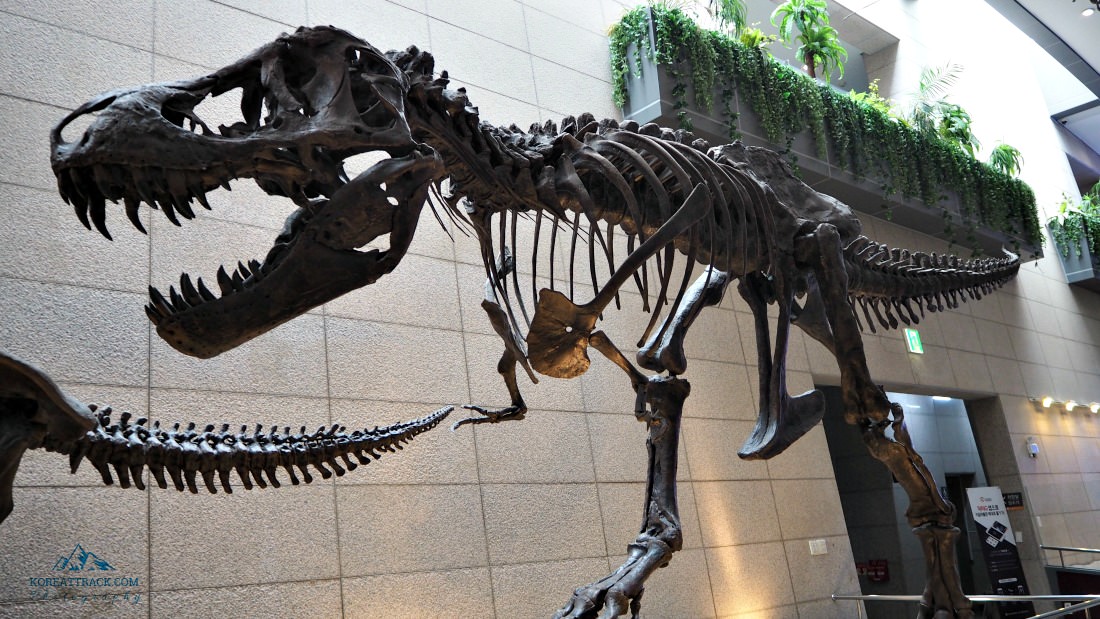 Tyrennosaurus Rex or the T-Rex Dinosaur
Tyrennosaurus Rex or the T-Rex DinosaurIntroduction
Kigam Geological Museum offers a unique experience for any visitor. Learn about the history of our planet and the geological processes that have shaped it by exploring our collections.
From fossils to minerals, Kigam Geological Museum has something for everyone. The museum's knowledgeable staff is on hand to answer questions and help you discover new things.
They also offer educational programs geared towards all age groups from kids to adults. Come and explore the wonders of Kigam Geological Museum!
The museum features interactive exhibits that allow visitors to get up close and personal with their collections. They also have a research library where you can find books, magazines, and videos about geology, paleontology, and other areas of scientific study.
At Kigam Geological Museum, they strive to make science accessible for everyone. They offer a variety of programs and activities designed to engage and educate the guests.
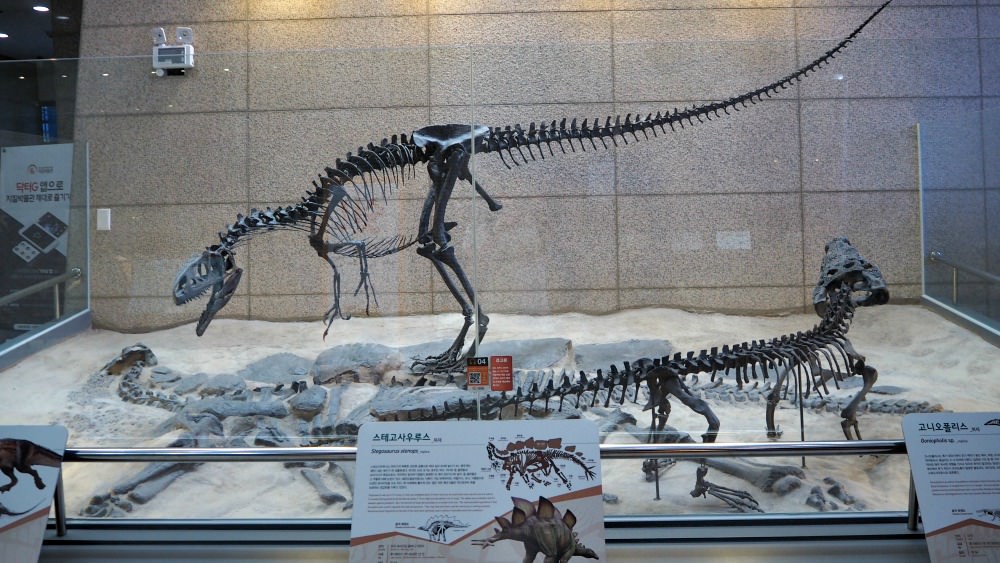 Stegosaurus Dinosaur's Skeleton Fossil
Stegosaurus Dinosaur's Skeleton Fossilkigam geological museum
Kigam Geological Museum (KIGAM stands for Korea Institute of Geoscience and Minerals) is an exciting public facility that exhibits fossils and minerals as representative attractions.
Besides the dinosaurs and ancient fossils, the facility also offers theatre, children's library, and more interesting educational services.
Personally, as far as I can remember, it was my first time to see dinosaurs "face-to-face." Yes, face-to-face with fossils of dinosaurs!
Most of the fossils are from other countries. As far as I know, there is no fossilized dinosaur YET uncovered in Korea.
But, already there are signs that dinosaurs also walked or existed in Korea some millions of years ago--as proven through the fossilized footprints imprinted on rocks (mud).
FACT: About 200 dinosaur eggs found in Hwaseong City, hwere the largest dinosaur egg site in Korea is located (KIGAM)
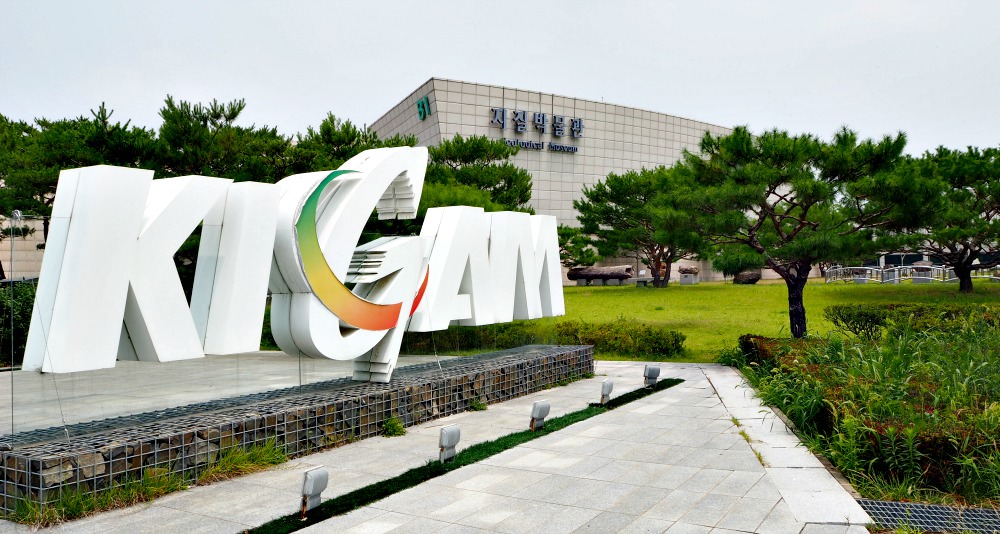 Korea Institute for Geology and Mineral Resources (KIGAM) side view
Korea Institute for Geology and Mineral Resources (KIGAM) side viewSince 1918 to the Present
Main Hall
The geological samples being exhibited at Kigam Geological Museum are the results of research efforts which started since 1918.
The research products have been first exhibited for public viewing was in 1992 at this same museum (Geological Specimen Room). The specimens were also exhibited during the Daejeon EXPO in 1993.
Since the public exhibition events, the continued research efforts expanded and the more systematic and organized structure was built, which led to the opening of Kigam Geological Museum in 2001.
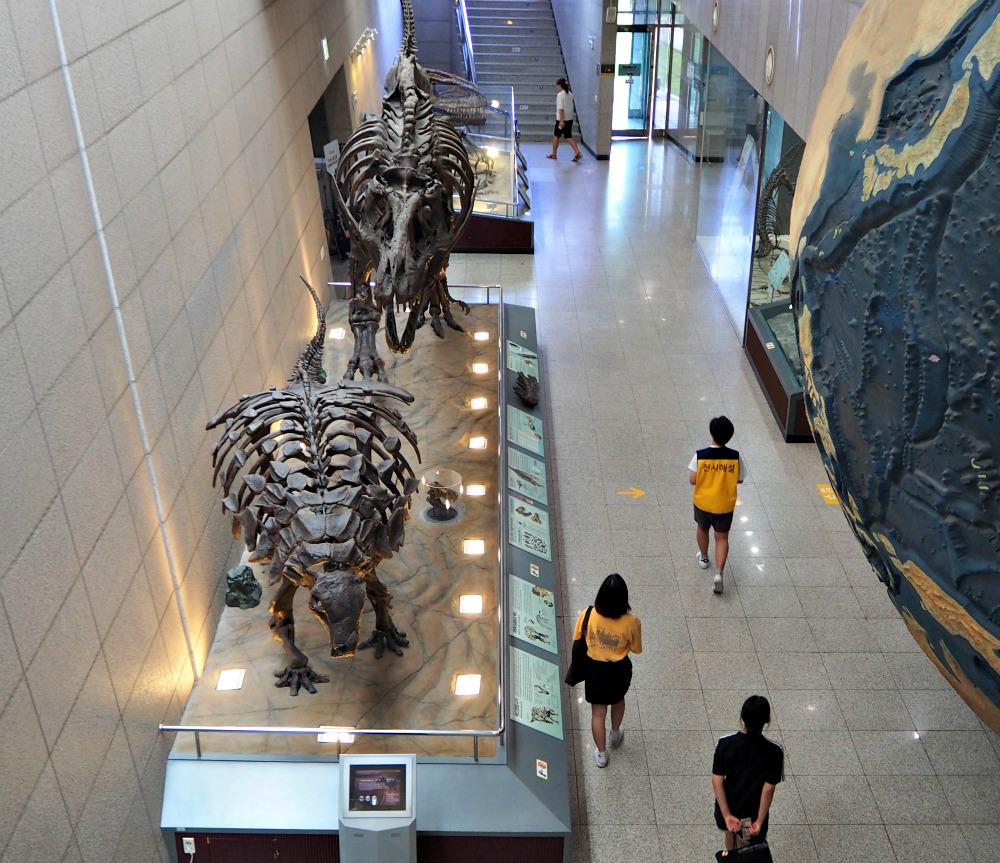 Main Exhibition Hall at KIGAM Museum
Main Exhibition Hall at KIGAM MuseumThrough this geological museum, various movie screenings, lectures, experienced-based learning on different specimen have been accomplished, exhibited and other ongoing activities.
With a capacity of around 2,500 square meters, you will have time to explore and enjoy at your heart's content the fossils, ancient, rocks, meteorites, and minerals, among many collections.
At the Sample Repository building, the KIGAM Geological Museum authorities are busy sampling specimen and archiving the drilled materials for easy further research.
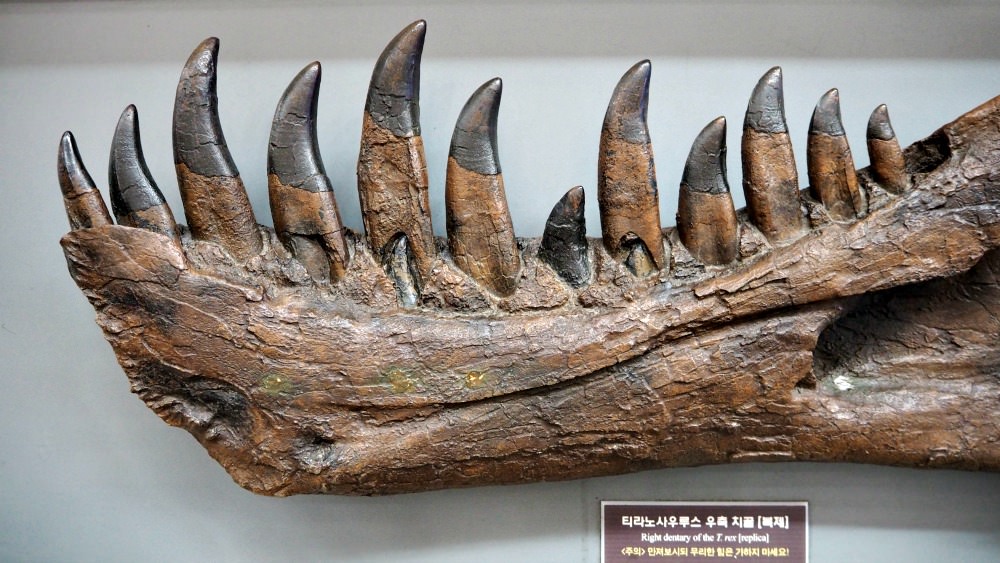 Right dentary side of T-Rex
Right dentary side of T-RexTyrannosaurus Rex
Tyrannosaurus Rex Dinosaur. Tyrannosaurus Rex is one of the most famous dinosaurs in the world. It is known for its large size, power and fearsome jaws. The T-Rex lived during the late Cretaceous period and was one of the last non-avian dinosaurs to exist before the extinction event. Its fossil remains have been found mainly in North America, although isolated specimens have also been found in Asia.
T-Rex was one of the largest predators that ever lived, measuring up to 40 feet long and standing around 20 feet tall at the hips. Its limbs were muscular and its tail was extremely powerful, giving it a better balance when hunting on two legs. It had a massive head with razor sharp teeth, perfect for tearing its prey apart. Its bite was even capable of crushing bone.
In addition to being one of the most fearsome predators ever, T-Rex also had some impressive senses. It had keen eyesight and a sophisticated sense of smell that allowed it to detect potential prey from great distances. Its hearing was also extremely sensitive, giving it the ability to detect low-level sounds.
T-Rex lived during the late Cretaceous period and was one of the last non-avian dinosaurs alive before their extinction 66 million years ago. It was most commonly found in North America, although isolated specimens have also been found in Asia and Europe. The exact cause of the extinction of T-Rex and other non-avian dinosaurs still remains a mystery.
Despite its fearsome reputation, scientists believe that T-Rex may have had a softer side too. Some research suggests that it may have been an obligate scavenger instead of a hunter and could even have lived in family groups. Its exaggerated features, such as the large head and small arms, were likely used for mating and social purposes.
T-Rex's senses were well adapted to its environment. Its powerful eyesight enabled it to detect motion from a fair distance. It had an acute sense of smell that allowed it to sniff out potential prey or rivals from miles away. And its hearing was enhanced by its large ears.
The fate of the T-Rex and its cousin species is still a mystery, but there are several theories as to what may have happened. Some believe that a massive asteroid struck the Earth 65 million years ago, with devastating effects on all forms of life. Others suggest that disease, climate change or changes in food availability may have caused the extinction of T-Rex.
Whatever its cause, the demise of this incredible creature marks a significant turning point in Earth's history. The era of dinosaurs had come to an abrupt end and mammals began to take their place as the dominant land creatures.
With no living descendants, the mighty T-Rex has become one of the most mysterious and fascinating creatures in natural history. The T-Rex is an amazing creature, one that will continue to amaze us for years to come.
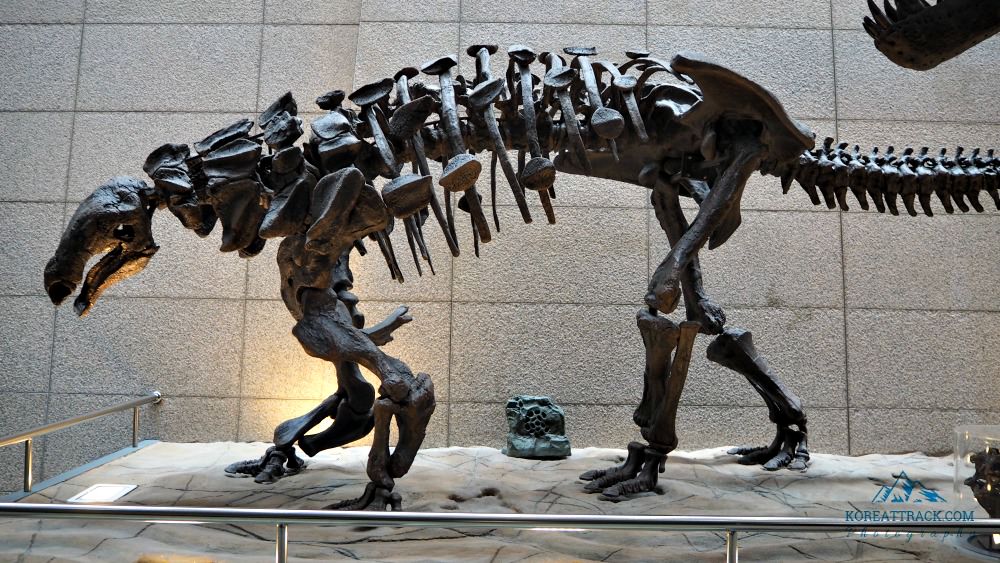 Stegosaurus fossil at KIGAM Museum
Stegosaurus fossil at KIGAM Museum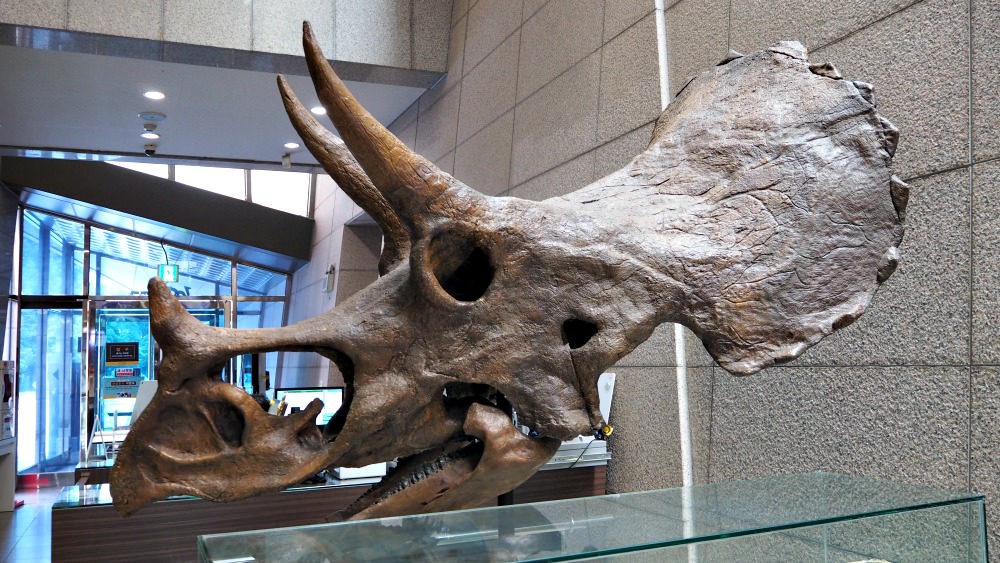 Tricerotops head fossil
Tricerotops head fossil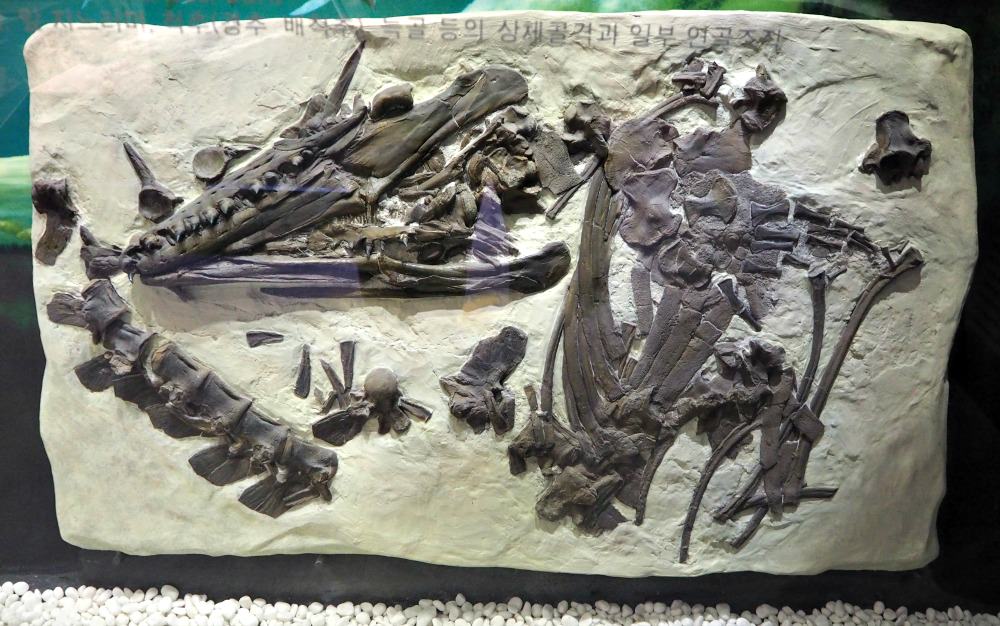 Dinosaur fossil at the Main Hall
Dinosaur fossil at the Main Hall Dinosaur fossils at the Main Hall
Dinosaur fossils at the Main HallNOW, besides the giant T-Rex fossil that catches your attention upon entering the museum, you will discover more impressive specimens. See them below...
1st exhibition hall - humans and life
Aside from dinosaurs, minerals, plant, and animal fossils, you can also find some specimen of human skulls and bones. Changes through adaptation and time are shown through the shapes of human's origins.
Birds and animals, not dinosaurs, are also introduced with the specimen and some replicas as exhibits.
You will find more exciting and surprising items protected with glass windows at the 1st Exhibition Hall.
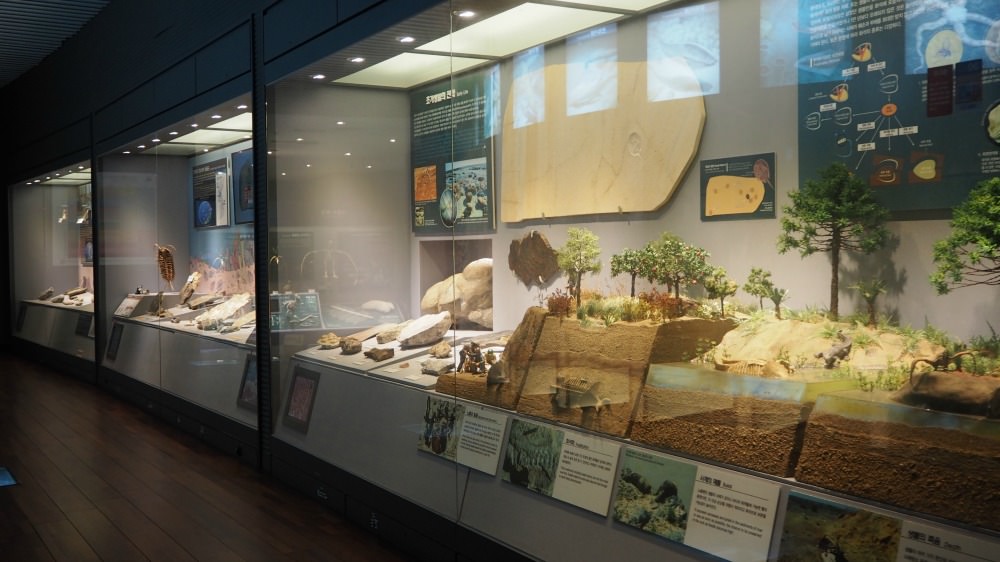 Window showing fossils and fossilization process
Window showing fossils and fossilization process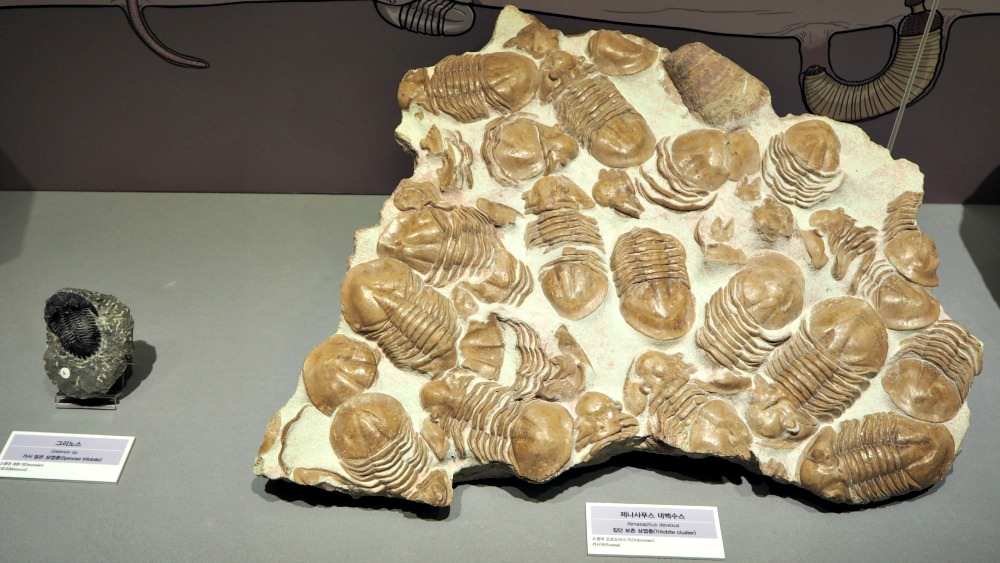 Fossils of Trilobite (Russia)
Fossils of Trilobite (Russia)2nd Exhibition Hall - gems & minerals
Around 5,000 fossils, minerals, rocks... are being exhibited at KIGAM Geological Museum (free for all visitors to see).
Find your birthstone, if you are fond of your designated gem. Yes, you can see varied collections of rocks and minerals from the bowels of the Earth or from the rivers or caves.
The minerals and rocks were systematized for the visitors or learners to easily categorize which rock or metal belongs to what group.
For example, one section organized the minerals as luminous stones. They specially set this up by creating a dark container that lets the stones to glow. Interesting!
Among others, one of my favorites are the pieces of meteorites exhibited. I like the iron meteorites that were cut to show this celestial element and made visible at this museum.
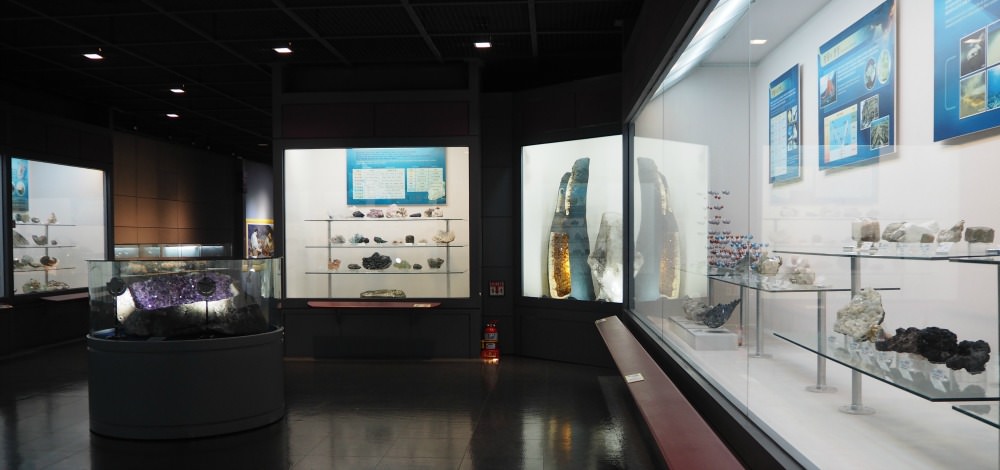 Interesting display of various minerals and gems
Interesting display of various minerals and gems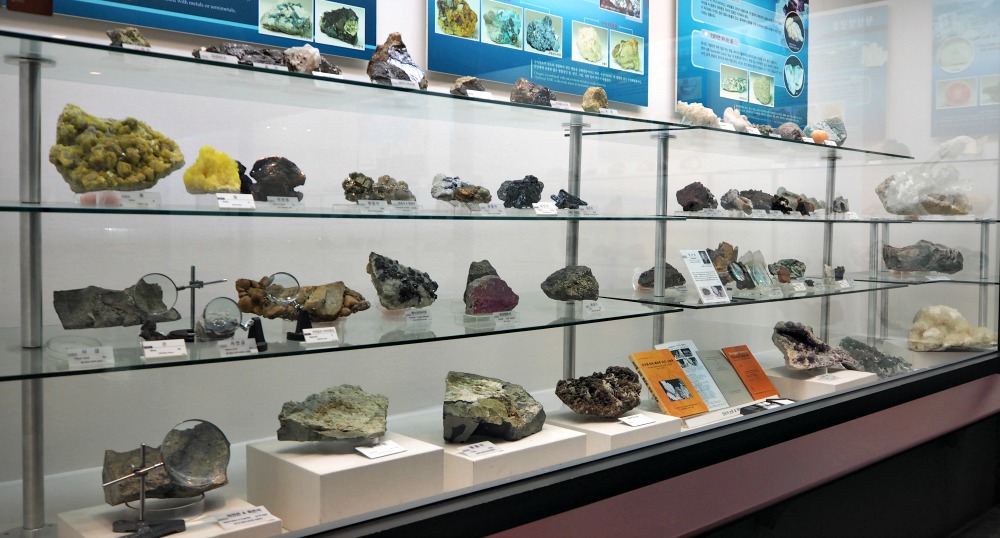 Various specimens of stones and minerals
Various specimens of stones and minerals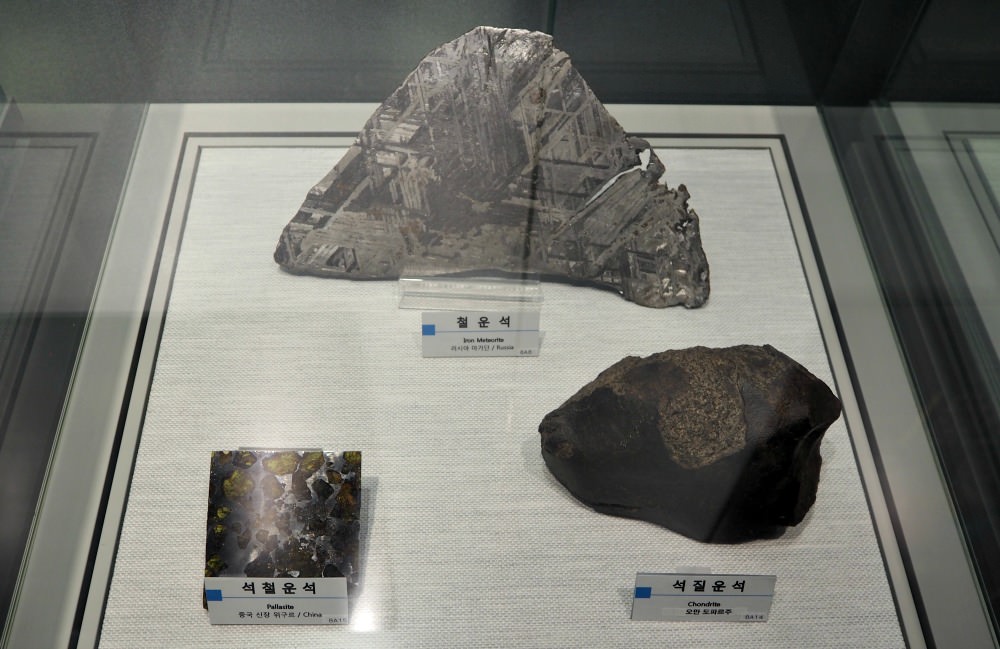 Iron specimens of meteorites
Iron specimens of meteorites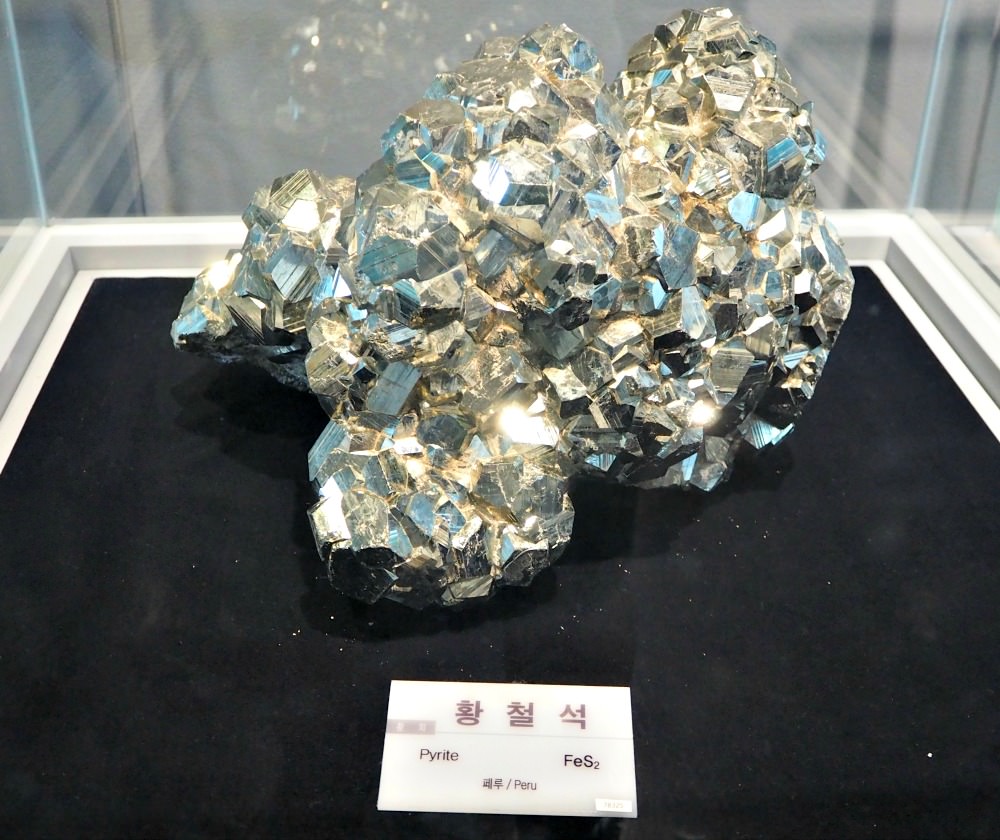 Pyrite mineral at KIGAM Geological Museum
Pyrite mineral at KIGAM Geological MuseumOutside garden Exhibitions
After having enjoyed the exhibits inside KIGAM Geological Museum, I decided to try and see the exhibits outside the building. Most of these exhibits are collections of boulders or big pieces of rocks and minerals of varied elements in the periodic table.
Such specimens include fossilized or petrified wood, limestones, gneiss, conglomerate, calcite, ammonites, and more stone elements found on Earth.
You can stretch your legs and muscles while walking around these huge and solid elements set over the spacious lawn of green grass.
Outside, you can find some benches near the trees and under their shades. I believe these are for anybody who wants to rest or take some time to eat something.
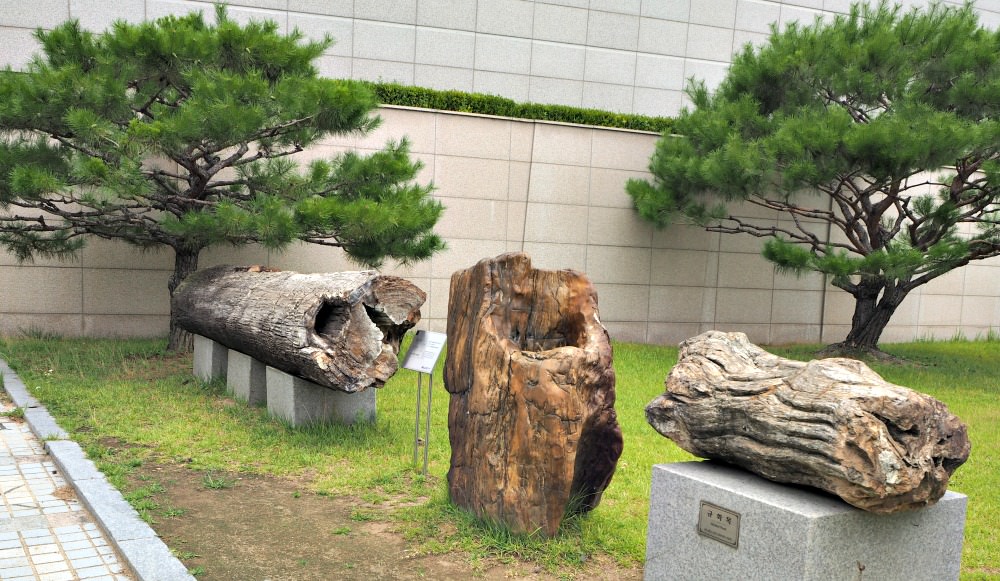 Petrified (fossilized) wood of different species in the exhibition garden
Petrified (fossilized) wood of different species in the exhibition garden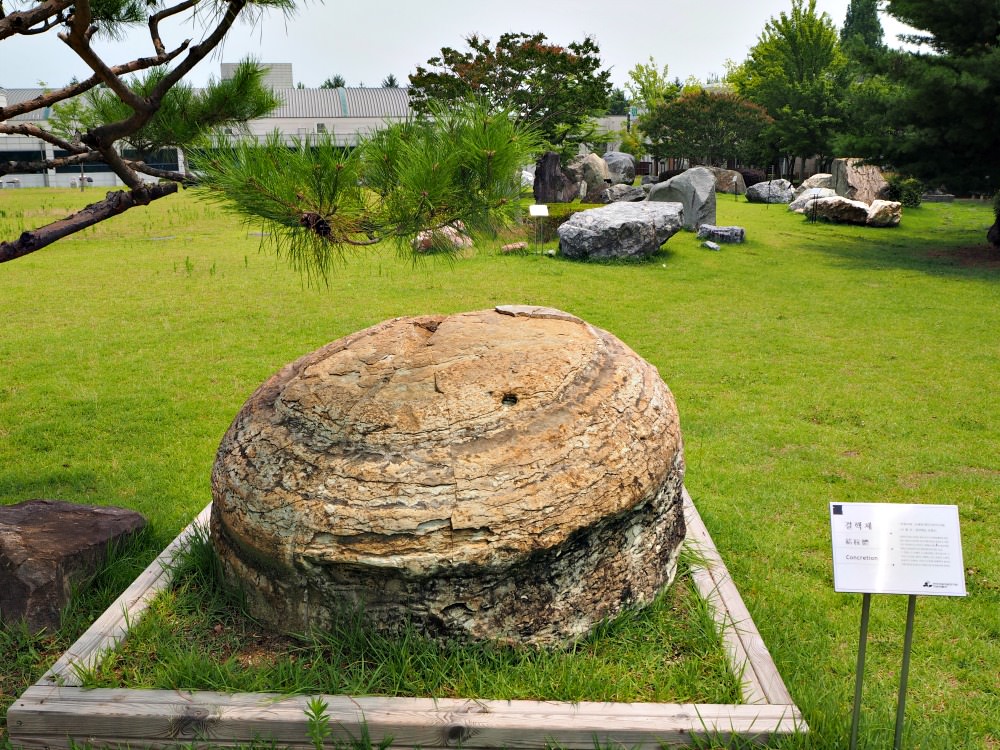 Unique round-shape rock exhibited at the garden in KIGAM
Unique round-shape rock exhibited at the garden in KIGAMBuilding Exterior Facade
Although it was a hot summertime in Daejeon, I dared to come out from the cold temperature inside to see the outside exhibitions.
Upon reading the museum's website, I have learned that it is designed similar to the dermal plates of Stegosaurus (dinosaur).
Yes, it seems like a dinosaur when I checked out my photo of the building which I took when I explored the large stones outside.
Repository Hall Building
This is where the specimen of collected minerals and newly-drilled materials waiting for study.
IT is located at the back or directly behind the museum building. Right in front of this repository building are the rocks or elements set up as exhibits.
other facilities
Aside from the main exhibition hall, you can also explore other rooms and facilities, including the theater room, children's library, and a special exhibition hall.
Automated Information System
You can use the Smartphone Automated Information System by accessing the information. Using this system will make you listen to the descriptions of the items you are looking at.
First, you need to download either the iPhone or Android App to avail the service. Then, you may choose the NFC, QR Code, or number/list choice set per item available as exhibits.
Audio Guide Player
If you want, you can also rent an audio guide player to hear the descriptions of each exhibit.
It is FREE, fortunately! Just prepare your ID Card then you will be given not only one but two players if you need.
Convenience Facilities
Museum Shop
You may purchase gifts, souvenirs, educational materials, and books related to science and geology.
Samples of ammonite fossils, kiddie toys, bags, handkerchiefs, and other decorative products are also available.
Museum Cafe
It is located inside the Kigam Lounge where you can relax at their comfortable chairs while sipping your favorite drinks or trying a slice of cake.
kigam location
Kigam Geological Museum is located just a few minutes outside Daejeon City. A bus or taxi ride will bring you there in less than 30 minutes.
Address: 124, Gwahak-ro, Yuseong-gu, Daejeon, 34132, Rep. of KOREA
Phone: +82-42-868-3797~8
Website: https://museum.kigam.re.kr/html/en/
Getting to Kigam Geological Museum
From any of the station you arrive, you can quickly get there either by bus or taxi. I took a cab from Yuseong Intercity Bus Terminal and got there in around 15 minutes or less.
Then I took Bus 604, which comes every 18 minutes. The bus stop is located about 20 meters ahead after crossing the main road.
From Daejeon Station
Daejeon subway station → Bus 604 → Get off at Korea Institute of Geoscience and Mineral Resources. The time travel is around 40 minutes.
From Daejeon Subway Station head for Gate 4 and then get off at Government Complex Daejeon Station - Dunsan Police Station bus stop (32-160). From this bus stop catch Bus 604 and then get off at Korea Institute of Geoscience and Mineral Resources.
From Daejeon Terminal Complex
Bus 102 → Bus 604 → Get off at Korea Institute of Geoscience and Mineral Resources (KIGAM Museum). Travel time is around 47 minutes.
From the Terminal Complex Bus Stop (12-101) take Bus 102, then get off at Government Complex Daejeon Subway Station bus stop (32-270). Then head towards Dunsan Police Station Bus Stop (32-160). At this bus stop, catch Bus 604, then get off at Korea Institute of Geoscience and Mineral Resources.
overall impressions
It was an exciting experience for me. The dinosaur fossils, other fossils, stones, and minerals made my day. I was delighted with my experience, and it was a good start.
I understand that they are still in the process of expanding by doing more research and studies. I hope that they can add more items and specimens to attract more visitors and offer more educational materials.
Probably, aside from studying how things exist in the past and the existing elements, they could also show how to slow down, or even better, stop the destruction and disappearance of the existing living plants and animals. Just a thought as a concerned environmental being.
Thanks for stopping by and reading this article based on my experience.
Hope this is helpful.
- Home
- Daejeon Travel Attractions
- Kigam Geological Museum
Get Exciting Activities
Book one of our exciting activities today to experience the thrill of a lifetime! Take advantage of this opportunity and secure your spot in advance.
Hotel Map Guide
Find your affordable, accessible, and comfortable hotel in Seoul at Agoda.Com. See the hotel map below...
Hotel Booking Guide
Find affordable and amazing hotels on Agoda.com using the search box below. Book now to enjoy great discounts and save!



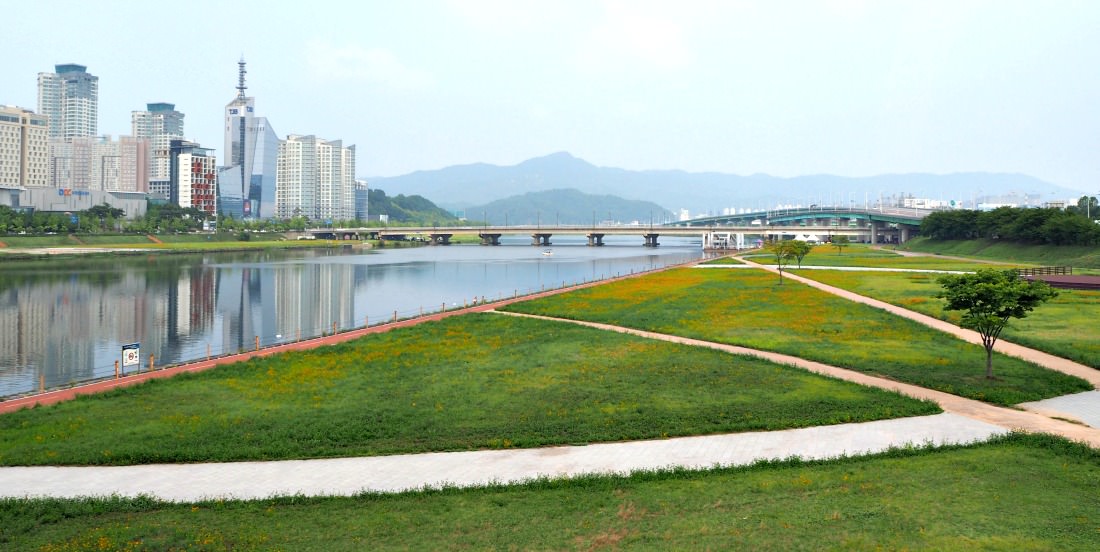




New! Comments
What do you think about this page? Leave me a comment in the box below.